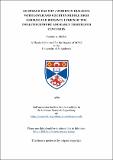Files in this item
So sprach daz Wip : women in dialogue with lover and court in Middle High German and Romance lyrics of the twelfth century and early thirteenth centuries
Item metadata
| dc.contributor.advisor | Ashcroft, Jeffrey | |
| dc.contributor.author | Mallett, Yvonne A. | |
| dc.coverage.spatial | 153 p. | en_US |
| dc.date.accessioned | 2018-07-11T08:32:43Z | |
| dc.date.available | 2018-07-11T08:32:43Z | |
| dc.date.issued | 1989-07 | |
| dc.identifier.uri | https://hdl.handle.net/10023/15222 | |
| dc.description.abstract | It is the purpose of this thesis to study a representative group of Middle High German poems, complemented in places by relevant Romance examples, in order to examine the image and position of the woman as portrayed through her relationships with her lover and the listening public. The first chapter looks at the early dialogue-songs which are characterised by the fact that the lovers do not generally communicate directly, but only talk about each other. Their sexual aspirations remain unfulfilled because of social restrictions. The last part of the chapter introduces an answered dialogue which gives new insights into the relationship between the protagonists and the listening public. The second chapter concentrates primarily on Reinmar's and Walter's dialogue-songs. It establishes that the image of the woman in these poems is determined by the poets' own needs and aims. The third chapter approaches the question of the variation of the image of the woman through an inquiry into the dawn-song. While following the development of the position of the woman from the potentially tragic to the comic it also illuminates the relationship between the woman and the male figures who appear in this genre. The final chapter sets against this an inquiry into the position of women in crusading and parting songs. These poems are all prompted by real-life situations. It concludes with a discussion of the way in which the woman's status depends upon her lover, as well as a description of changing attitudes towards the crusading movement. The most important overall conclusion is that the image of the woman is far more varied than is generally thought and that this diversity depends on the interplay between real-life observation and subsequent poetical relationship. | en_US |
| dc.language.iso | en | en_US |
| dc.publisher | University of St Andrews | |
| dc.subject.lcc | PN1091.M2 | |
| dc.subject.lcsh | Poetry--History and criticism--Early works to 1800 | en |
| dc.subject.lcsh | Middle High German poetry | en |
| dc.subject.lcsh | Love in literature | en |
| dc.title | So sprach daz Wip : women in dialogue with lover and court in Middle High German and Romance lyrics of the twelfth century and early thirteenth centuries | en_US |
| dc.type | Thesis | en_US |
| dc.type.qualificationlevel | Masters | en_US |
| dc.type.qualificationname | MPhil Master of Philosophy | en_US |
| dc.publisher.institution | The University of St Andrews | en_US |
This item appears in the following Collection(s)
Items in the St Andrews Research Repository are protected by copyright, with all rights reserved, unless otherwise indicated.

